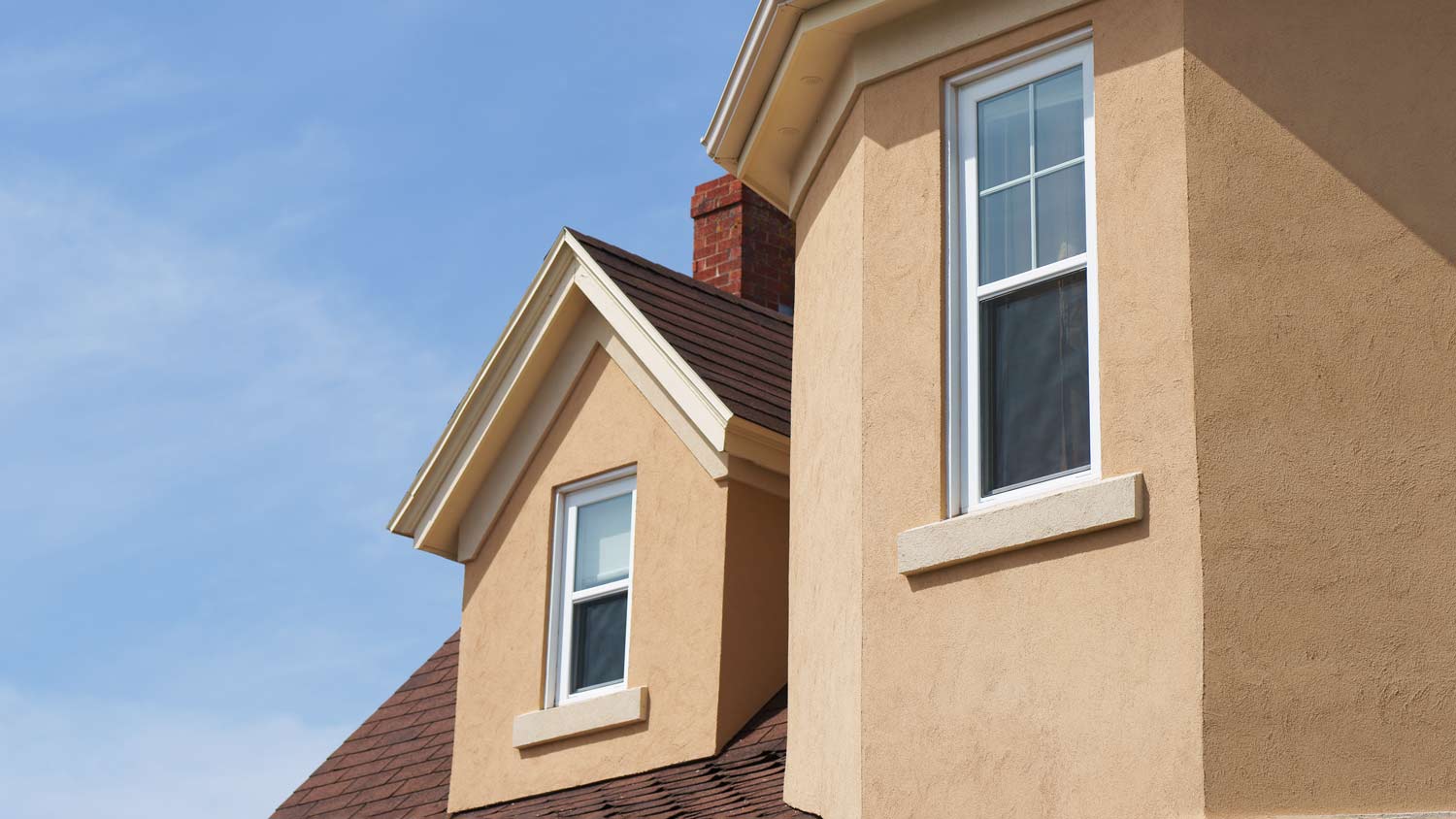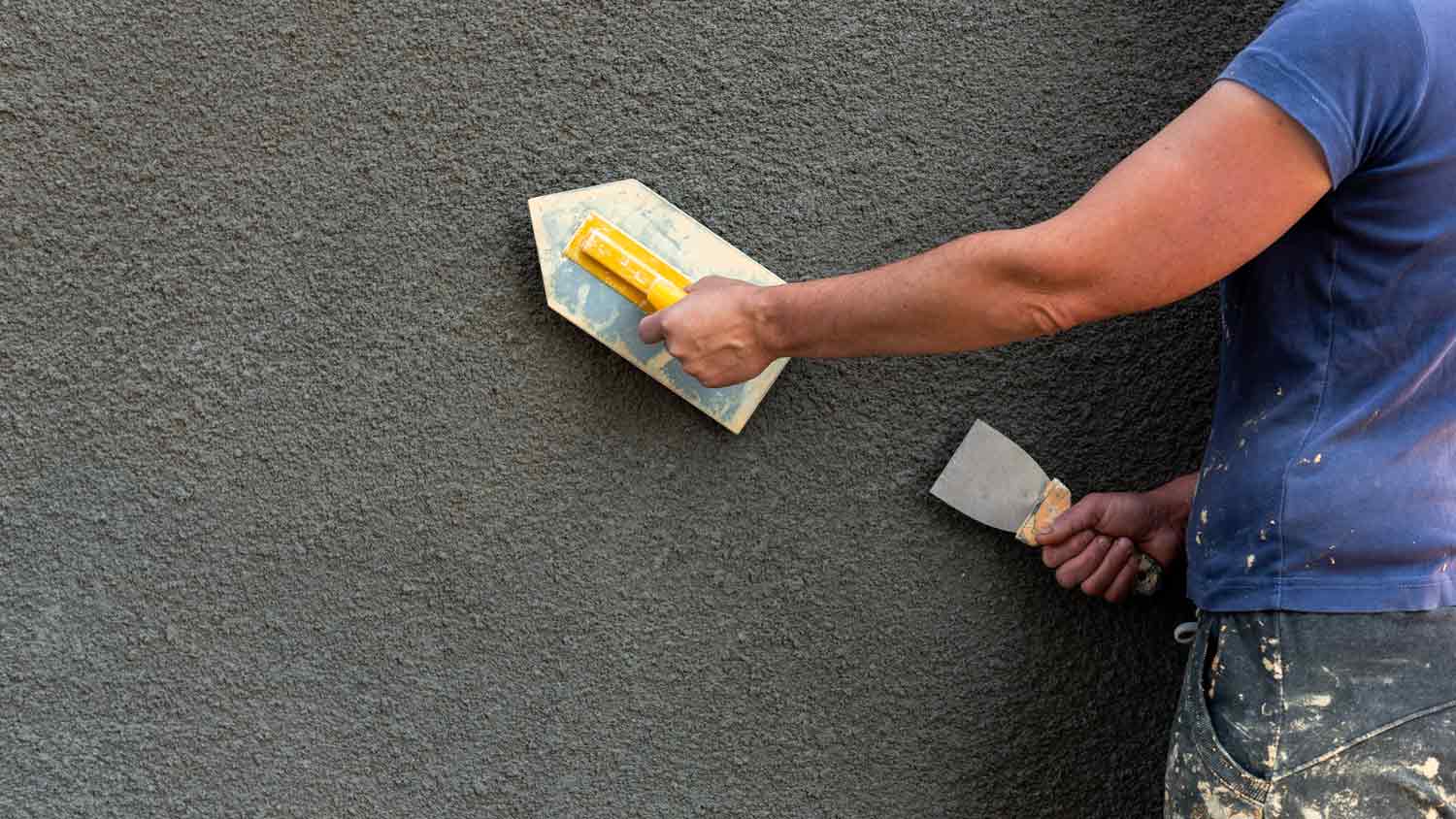The Pros and Cons of Stucco Siding for Your Home
There’s good and bad on both sides of this debate


Stucco siding is ideal for homeowners who value durability and live in areas prone to fire and pest problems.
In addition to being long-lasting, stucco has other pros: It’s versatile and easy to maintain.
The cons of stucco include its porosity, painting difficulties, and the need for professional installation.
Common alternatives to stucco siding include vinyl, wood, and fiber cement.
Curb appeal is important, but your home’s exterior also needs to stand up against issues like weather, fire, and bugs. Stucco siding is an option, but is it the best one? Here’s everything you need to know about stucco—its pros, cons, and whether it’s right for you.
What Is Stucco?

Stucco is a type of siding made from a mixture of Portland cement, sand, lime, and water. The cement-based exterior finish is applied in three layers—a scratch coat, a brown coat, and a finish coat—to create a seamless, textured surface on the outer walls of your home. These distinct layers are what give stucco its best—and worst—features.
The scratch coat is the first layer of stucco that’s applied directly to the base material of your house. True to its name, it creates a scratched, rough surface that helps the other layers stick to it. The brown coat smooths out the exterior surface while also adding thickness and bulk. The final layer, known as the finish coat, is customizable to the likes of homeowners who want to achieve a unique appearance for their home.
Stucco siding has long been a favorite for many reasons. Its application process already hints at its durability and versatility, but it’s not perfect.
| Pros of Stucco | Cons of Stucco |
|---|---|
| Durable | Not suitable for all climates |
| Long-lasting | Requires skilled installation |
| Curb appeal and versatility | Difficult to paint |
| Easy to maintain | Frequent maintenance |
Pros of Stucco
Whether you’re considering stucco for a new build or curious about your home’s existing exterior, there are plenty of reasons to choose stucco siding. The material is known for its durability, long lifespan, curb appeal, and easy maintenance.
Durability
The purpose of siding is to protect your home from external elements, and stucco siding does that. Stucco is cement-based, so it’s resistant to fire, rot, and pests like termites. Stucco siding can also withstand high winds and even resist impact damage from extreme conditions like heavy rain and ice. When properly installed, stucco siding offers long-lasting durability for many homeowners.
Longevity
On average, stucco siding can last up to 50 years. With professional installation, routine maintenance, and favorable weather conditions, homeowners can stretch the lifespan of stucco siding to 80 or 100 years.
Curb Appeal
The versatility of stucco siding makes it an ideal choice for adding curb appeal. Stucco offers a wide range of styles and design options and can be customized with different textures, from smooth and sleek to rough and rustic. You can tint the finish coat to virtually any color. It can also be further customized with unique textures and patterns.
If you live in an area where stucco is popular, you don’t have to worry about your house looking identical to your neighbor’s. Because of the diverse designs you can integrate into your stucco, you can easily achieve a one-of-a-kind appearance that adds personality and makes your home more aesthetically pleasing.
Easy Maintenance
If your stucco siding is properly installed, it’s a hassle-free exterior that requires minimal upkeep. There isn’t a lot of work needed to keep its beauty and durability. You don’t have to worry about rot or pest infestations, but its routine maintenance may have you cleaning away small stains, pressure washing the exterior, and repairing small hairline cracks or chips.
Maintaining stucco also includes resealing and repainting; however, you rarely have to worry about these projects. You can get away with resealing your stucco every five to 10 years and push off painting jobs to once a decade.
Cons of Stucco
While stucco siding is an ideal option for many people, it’s not right for everyone. Some homeowners stray away from stucco because of its weather restrictions, frequent maintenance, and difficulty in painting and DIY installation.
Susceptible to Cold, Wet Weather
Stucco siding is a favorite for homeowners in states like Nevada, Arizona, and New Mexico. Why? Stucco is great in dry climates but isn’t suitable for all climates—specifically cold, wet areas.
Stucco may be able to withstand the impact of heavy storms, but freezing, wet weather is its kryptonite. Stucco is a porous material, making it easy for moisture to pass in and out. Moisture from humidity, rain, snow, and ice can get trapped and—depending on your location—freeze beneath the surface. This can eventually cause cracking, water damage, and if left untreated, mold.
Stucco is ideal for drier climates, whether they’re hot or cold. However, if you live in colder climates with lots of precipitation and frequent freeze-thaw cycles, think again. This repeated process where the temperature drops below freezing, rises above it, and falls again can damage your stucco.
Requires Professional Installation

If you’re looking for a DIY siding project that doesn’t require a heavy lift, look somewhere else. Installing stucco siding requires experience, skill, technique, and specialized tools. The installation can take weeks. The process involves preparing your home’s exterior surface, monitoring the weather for ideal conditions, and checking local building codes. And this doesn’t even cover mixing the layers to their perfect consistency and letting them cure for 48 hours to a week. Poor stucco installation can lead to a big, expensive stucco repair or replacement. The best way to guarantee a job well done is by hiring a professional stucco contractor.
Frequent Maintenance
How can stucco maintenance be both a pro and con? While stucco siding is easy to maintain, it often requires frequent fixes.
One of the reasons that stucco is so durable is because it isn’t flexible—but its rigidity makes it prone to cracking. These cracks happen when the material expands and contracts because of changing temperatures or weather. Even shifting soil can cause cracks to develop. Patching up cracks is relatively simple. While it won’t take an entire afternoon, finding and fixing cracks as soon as they appear is the best way to keep your stucco in great shape.
You should plan on inspecting your stucco at least once a year in order to find and repair small cracks before they get worse.
Difficulty Painting
The decision to repaint your home is a big commitment, but it’s a lot harder when you have stucco siding. One of the biggest benefits when installing stucco is the versatility to make it any color you want. And you’ll want to be sure of your decision, because painting stucco isn’t easy.
There are several reasons why painting is one of stucco’s most common problems. Its porosity makes it relatively impossible to achieve an even, consistent finish without applying multiple coats. The varying textures also make it difficult to cover all the nooks and grooves. And you can forget about painting shortly after a storm. Painting over damp stucco can trap moisture beneath the paint and cause aesthetic issues like peeling and bubbling or bigger problems like mold.
If you want to paint your stucco, you need to sandblast it first. This smooths out the surface by blasting it with a highly pressurized combination of sand and air. Painting stucco isn’t impossible, but it requires careful preparation, the right materials, and a skilled approach.
Alternatives to Stucco
If you don’t like stucco, you don’t have to use it. Some of the most popular siding options among homeowners include:
Vinyl
Wood
Fiber Cement
Metal
Stone
Brick
A DIY project to remove stucco ranges from $50 if you already have the necessary tools to $500 or more.
Is Stucco Right For You?
Stucco siding is ideal for homeowners who value durability, longevity, and aesthetic appeal. You might find yourself gravitating towards stucco if you live in regions with extreme weather conditions—excluding very cold and wet climates—or areas prone to fire and pest issues. Stucco could be a great option if you’re not put off by occasional maintenance and inspections to manage minor problems like small cracks and chips. If you’re looking for a long-lasting, low-maintenance exterior that offers design versatility and curb appeal, stucco may be right for you.
Frequently Asked Questions
On average, the cost of stucco siding is $5,594, but it can range between $2,193 and $9,061. Stucco prices depend on several factors including labor and materials, the complexity of your home, your desired color and finish, and the popularity of stucco in your area; however, no factor affects the cost more than the size of your home. Ways to save money on your stucco installation include removing the old siding yourself and planning your installation during the off-season months.
Traditional and synthetic stucco each have pros and cons that make one potentially better than the other, but this depends on your specific needs. While both are durable, synthetic stucco has an extra layer that makes it more durable and resistant to cracking. Traditional stucco is more affordable and less likely to trap moisture than its synthetic alternative. Synthetic stucco offers more color options and requires less maintenance.





- What is Stucco Siding? And How Is It Used in Homebuilding?
- Stuck on Stucco? 6 Stucco Maintenance Tips to Increase Its Life Span
- Stucco vs. Brick: Pros, Cons, and Costs
- Replacing Windows in Stucco Homes: 6 Things to Keep in Mind
- Fiber Cement Siding vs. Stucco Siding: A Guide
- How to Hang Christmas Lights on Stucco Without Drilling Holes
- 7 Low-Maintenance Siding Options for Your Home
- The Pros and Cons of Different House Siding
- 12 House Siding Options to Boost Curb Appeal
- 5 Best Chimney Siding Ideas For Protection and Appearance










